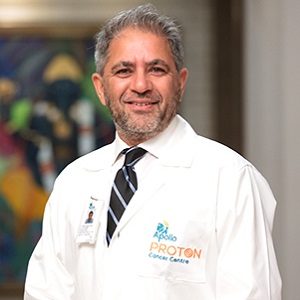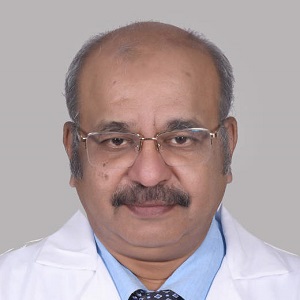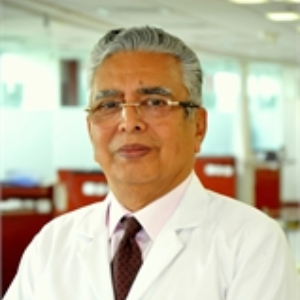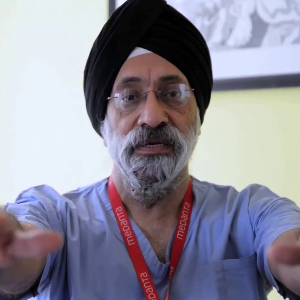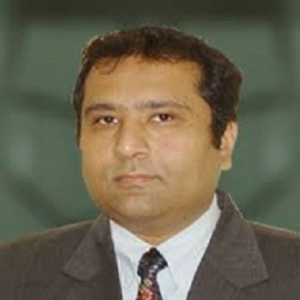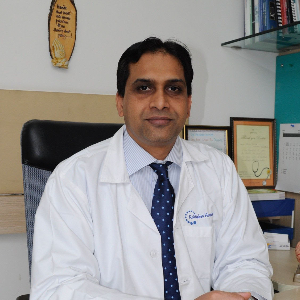Best Cyber Knife Radiosurgery Doctors in India
- Neuro Oncologist, Chennai, India
- Over 28 years’ experience
- Apollo Proton Cancer Centre
Profile Highlights:
- Dr. Rakesh Jalali is undoubtedly one of the top Radiation Oncologists in the country who is renowned for his high-precision radiation techniques.
- He provides a wide range of radiation treatments customized to treat different kinds of cancers.
- Dr. Jalali, who has a remarkable 28-year of experience in the field of Neuro-Oncology, is highly proficient in employing sophisticated radiation treatment procedures, such as Electron Beam Radiation treatment (3DCRT), IMRT, IGRT, VMAT, BRT, SABR, DIBH, Brachy Treatment, TBI, and TSET, as well as 4D Gated Radio Treatment. These treatments are carefully employed to treat various kinds of cancers such as brain tumors, breast cancer, lung cancer, prostate cancers, and many more.
- Top Neurosurgeon | Artemis Hospital | Gurugram, India
- 25+ years experience
- Artemis Hospital, Gurgaon
Profile Highlights:
- Dr. Aditya Gupta is one of the top Neurosurgeons in India functioning as the Chairperson of the Department of Neurosurgery & CNS Radiosurgery and Co-Chief of Cyberknife Centre at the Artemis Hospitals in Gurugram, India.
- He is renowned for pioneering advanced surgical techniques in treating various brain tumors, specializing in microsurgery and radiosurgery. His expertise extends to managing Movement Disorders with Deep Brain Stimulation (DBS), epilepsy surgery, nerve and brachial plexus surgeries, as well as treating brain aneurysms and AVMs. He is also highly skilled in spine surgery, having performed a wide range of procedures.
- Dr. Gupta graduated as a topper from All India Institute of Medical Sciences, New Delhi. He later served as Faculty and Associate Professor of Neurosurgery until 2009.
- Radiation Oncologist, Gurugram, India
- Over 32 years’ experience
- Medanta-The Medicity, Gurgaon
Profile Highlights:
- Dr. Tejinder Kataria is a globally renowned Radiation Oncologist whose pioneering contributions have significantly advanced cancer treatment in India.
- With over 35 years of experience, she has been instrumental in introducing cutting-edge technologies and establishing prominent oncology departments across prestigious institutions. She is currently the Chairperson of Radiation Oncology at Medanta – The Medicity in Gurugram, New Delhi.
- Dr. Kataria played a pivotal role in founding the Department of Radiation Oncology at Rajiv Gandhi Cancer Institute, New Delhi, and Artemis Health Institute, Gurugram. She also established the Division of Radiation Oncology at Medanta, Gurugram, where she continues to innovate and lead.
- Her interests lie in Stereotactic Radio Treatment (SBRT), Image-Guided Radio Treatment (IGRT), Intensity Modulated Radio Treatment (IMRT), 3-D Conformal Radiation (3D CRT), PET-CT, MRI, SPECT, DSA and CT-Simulator fusion for treatment planning.
- Top Radiation Oncologist | Apollo Hospital, New Delhi, India
- 20+ Years Experience
- Indraprastha Apollo Hospital, New Delhi
Profile Highlights:
- Dr. G K Jadhav is one of the leading radiation oncologists in India.
- He has a complex understanding of cancer biology, clinical care, and radiation physics.
- Dr. Jadhav has an experience of more than 20 years in the field of radiation oncology.
- Radiation Oncologist, Gurugram, India
- Over 40 years’ experience
- Artemis Hospital, Gurgaon
Profile Highlights:
- Dr. Subodh Chandra Pande is a well-known radiation oncologist in India. He has a long and rich clinical and teaching experience in the specialty of radiation oncology.
- He included a Dual Energy Linear Accelerator with Multi-Leaf Collimator at Bhagwan Mahaveer Cancer Hospital and Research Centre (BMCHRC), Jaipur & which was a first for the State of Rajasthan.
- Top Neurosurgeon | Medanta_ The Gurugram | India
- 30+ years’ experience
- Medanta-The Medicity, Gurgaon
Profile Highlights:
- Dr. V P Singh is a renowned Neurosurgeon with over 30 years of veteran experience. His competence in cranial, spinal, and peripheral nerves has helped him successfully perform 400+ Intracranial Aneurysm surgical procedures.
- Dr. Singh has also been credited for initiating the Gamma Knife Unit and epilepsy surgery program at All India Institute of Medical Sciences, New Delhi.
- He is proactively involved in the treatment of arteriovenous malformations by radiosurgery techniques and is currently the chairman of the Institute of Neurosciences, Medanta.
- Neurosurgeon, Gurugram, India
- 20 + years’ experience
- Medanta-The Medicity, Gurgaon
Profile Highlights:
- Dr. Sudhir Dubey is a distinguished neurosurgeon with an illustrious career spanning decades, marked by groundbreaking contributions to the field of neurosurgery.
- As the Chairman of Neurosurgery at Medanta, Gurugram, Dr. Dubey has performed over 10,000 neurosurgical operations, solidifying his reputation as one of the foremost experts in the field.
- Dr. Dubey’s academic journey is as impressive as his clinical achievements. He graduated with top honors from King George’s Medical College, where he was awarded the prestigious Sir Rupkishan Das Gold Medal in his final year of MBBS.
- Top Neuro Surgeon & Spine Surgeon | Kokilaben Hospital, Mumbai, India
- 26+ Years Experience
- Kokilaben Dhirubhai Ambani Hospital
Profile Highlights:
- Dr. Abhaya Kumar is a leading name in the field of Neurosurgery in India and is currently associated with Kokilaben Dhirubhai Ambani Hospital, Mumbai as the Head and Consultant of Neurosurgery and Minimally Invasive Spine Surgery.
- He is an expert in Minimally Invasive Spine Surgery, Brain surgery, and Stereotactic Radiosurgery. He has performed more than 3500 spine surgeries and 5500 brain surgeries in KDAH alone.
- His primary focus includes Minimally Invasive Spine Surgery (MISS). Till date, he has handled over 2500 Minimal Invasive spine cases in the hospital with an outstanding success record.
- In addition, he has treated over 300 cases of Craniovertebral Junction anomalies and performed surgeries for approximately 3000 brain tumors and over 500 spinal cord tumors. He frequently utilizes advanced technologies like Intraoperative MRI (IMRIS), neuro-navigation, stereotaxy, and neuroendoscopy in his procedures.
- Radiation Oncologist, Chennai, India
- Over 25 years’ experience
- Apollo Cancer Centre
Profile Highlights:
- Dr. Mahadev P is a radiation oncologist with 25+ years of experience and has played a major role in starting the Diplomate of National Board course in Radio Treatment in 2005.
- After getting trained in Australia, Dr. Mahadev P started Prostate Brachy Treatment at Apollo Specialty Cancer Hospital.
- Dr. Mahadev is also trained in Cyberknife radiosurgery – the only system in the world to treat tumors in the body with sub-millimeter accuracy.
- Radiation Oncologist, Chennai, India
- Over 24 years’ experience
- Apollo Cancer Centre
Profile Highlights:
- Dr. Rathna Devi is a senior Radiation Oncologist who has an experience of 24 years in the field.
- She completed MBBS from M.S. Ramaiah Medical College, Bangalore University, and a Diploma in Radio Treatment from Madras Medical College, Dr. MGR Medical University.
- Dr. Rathna Devi’s areas of expertise include Cranial Cyberknife Radiosurgery, Intensity Modulated Radio Treatment (IMRT), and Stereotactic Body Radio Treatment (SBRT).
Best Cyber Knife Radiosurgery Hospitals in India
- City: Gurugram, India
Hospital Highlights:
- One of India’s best and largest multi-specialty hospitals, Medanta was built with the aim to bring India to the highest standards of medical care. The hospital has been providing the best medical services to its patients, since its inception, with care, commitment, and compassion.
- Equipped with 1250 beds, the hospital was founded by Dr. Naresh Trehan in the year 2009 with an aim to provide the best medical care at affordable costs. The hospital is spread across 43 acres and includes 45 operation theatres and 350 beds dedicated solely to ICU. The hospital includes over 800 doctors, and more than 22 specialty departments and has a dedicated floor for individual specialty in order to offer the best services under one roof.
- The hospital is considered one of the premier institutes in India for Cardiac Care and includes staffs and members of high caliber. The hospital has 6 distinct centers of excellence.
- City: Gurugram, India
Hospital Highlights:
- Artemis Hospital, established in 2007 in Gurugram, India, is a leading multi-specialty institution known for its excellence in patient care and advanced medical technology, offering comprehensive services across specialties like Cardiology, Oncology, Neurology, Orthopedics etc.
- Renowned for its patient-focused care, Artemis Hospital combines state-of-the-art infrastructure with a team of internationally trained doctors and surgeons, ensuring the highest standards of medical treatment.
- Accredited by JCI and NABH, Artemis Hospital meets global healthcare quality and safety standards, reflecting its commitment to providing compassionate, personalized care.
- The hospital is recognized for utilizing cutting-edge diagnostic and ther*peutic techniques, ensuring patients receive accurate diagnoses and effective treatments tailored to their needs.
- City: Chennai, India
Hospital Highlights:
- The Apollo Proton Cancer Centre in Chennai is the most sought-after private cancer hospital in India. It is an integrated facility that provides cutting-edge, all inclusive cancer treatment to patients all over the globe.
- The hospital is a part of the renowned Apollo Group which has a large network of over 74 hospitals in India and across the globe. Out of the 74 hospitals, 21 of them are cancer centres. However, Apollo Proton Cancer Centre is the only cancer hospital to have JCI accreditation.
- The Centre, which was established on the principles of excellence and expertise, unites a formidable medical staff led by some of the most illustrious figures in cancer treatment.
- The hospital follows the global ASTRO Model Policy. It is the same global policy which is followed by countries like USA, UK, and Europe.
- Apollo Proton Cancer Centre is among the very few hospitals in India to receive patients from First World countries such as USA, Canada, New Zealand, Australia, Singapore, Thailand, etc.
- Apart from that, it is also the first hospital in Chennai to receive patients from several countries like Uzbekistan, Kazakhstan, Turkmenistan, Georgia, Armenia, Azerbaijan, SAARC countries (Bangladesh, Nepal, Sri Lanka, Maldives, Bhutan, Afghanistan, and Pakistan), South Africa, Turkey, Egypt, etc.
- In fact, there is a dedicated team at the Apollo Proton Cancer Centre that serves only international patients. Thus, on a monthly basis, the Centre receives patients from across 32 countries.
- Moreover, there are certain treatments in Apollo Proton Cancer Centre that are not available in any other centre. APCC addresses all types of possible cancers that are usually not covered by any other centre.
- City: New Delhi, India
Hospital Highlights:
- Over the last 33 years, the Fortis Escorts Heart Institute has set new standards in cardiac treatment with groundbreaking research. It is now known around the world as a centre of expertise for Cardiac Bypass Surgery, Interventional Cardiology, Non-invasive Cardiology, Paediatric Cardiology, and Paediatric Cardiac Surgery.
- The hospital has cutting-edge laboratories that perform a wide range of diagnostic tests in Nuclear Medicine, Radiology, Biochemistry, Haematology, Transfusion Medicine, and Microbiology.
- Fortis Escorts Heart Institute boasts a diverse group of bright and experienced doctors who are backed up by a team of highly qualified, experienced, and devoted support professionals as well as cutting-edge equipment such as the recently installed Dual CT Scan.
- Approximately 200 cardiac doctors and 1600 personnel currently collaborate to manage over 14,500 admissions and 7,200 emergency situations each year. The hospital now has a 310-bed infrastructure, as well as five cath labs and a slew of other world-class amenities.
- City: New Delhi, India
Hospital Highlights:
- The Indian Spinal Injuries Center (ISIC), provides state-of-the-art facilities for the management of all types of spinal ailments.
- Staffed with internationally trained, acclaimed, and dedicated spine surgeons, the hospital provides cutting-edge medical & surgical technology. The hospital provides comprehensive management of spinal injury, back pain, spinal deformities, tumors, osteoporosis, etc.
- The hospital performs motion-preserving spine surgeries including disc replacement and dynamic fixation, and minimally invasive spine surgeries such as endoscopic disc excision.
- The orthopedic service of the hospital covers all orthopedic ailments including trauma, joint diseases & replacements, oncology, pediatric orthopedics & upper limb ailment.
- City: Faridabad
Hospital Highlights:
In the sprawling city of Faridabad, where healthcare needs are diverse and ever-evolving, one institution has consistently stood out as a beacon of excellence in the field of medicine—Marengo Asia Hospital. Established with a vision to provide world-class healthcare services to the community it serves, Marengo Asia Hospital has emerged as a trusted name synonymous with quality, compassion, and innovation in healthcare.
- City: New Delhi, India
Hospital Highlights:
- Indraprastha Apollo Hospital is a 700-bedded multispecialty hospital in the heart of the capital of India. It is a part of Apollo Hospital group, one of India’s most reputed healthcare chains. Indraprastha Apollo Hospital has been accredited by Joint Commission International, making it the first internationally accredited hospital in the country in 2005.
- There are 52 specialties in the hospital with one of the best cardiology centers in the country. The hospital is also equipped with State of the art infrastructure facilities with the largest Sleep Lab in Asia and the largest number of ICU bed facilities in India.
- The latest and highly advanced technologies that are installed in the hospital include Da Vinci Robotic Surgery System, PET-MR, PET-CT, Cobalt-based HDR, Brain Lab Navigation System, Tilting MRI, Portable CT scanner, 3 Tesla MRI, 128 Slice CT scanner, DSA Lab, Endosonography, Hyperbaric Chamber and Fibro scan.
- City: New Delhi, India
Hospital Highlights:
- One of the well-regarded providers in India committed to the highest standards of clinical excellence and patient care, Max Super Specialty Hospital is a part of Max Healthcare, which is the second-largest healthcare chain in India. Regarded as one of the most well-regarded healthcare providers in the country, Max Super Specialty Hospital is committed to the highest standards of clinical excellence as well as patient care. The hospital is also equipped with the latest technology as well as cutting-edge research. The hospital is known to deliver and ensure the highest level of patient care.
- The hospital has more than 500 beds and offers treatment for over 35 specialties. The hospital also holds the credit of having installed the first Brain Suite in Asia. This is a highly advanced Neurosurgical machine that allows MRI to be taken while surgery is ongoing.
- Other advanced and latest technologies are also installed in the hospital such as the 1.5 Tesla MRI machine, 64 Slice CT Angiography, 4D ECHO, LINAC, and 3.5T MRI machine.
- City: Kolkata, India
Hospital Highlights:
- Founded in 2017, the HCG EKO Cancer Centre is a committed, all-inclusive cancer care facility in Kolkata.
- The hospital was collaboratively established by India’s leading cancer care provider HCG (HealthCare Global Enterprises Ltd.), and EKO Diagnostic Pvt. Ltd., a top diagnostic and imaging chain in Eastern India.
- With 88 beds, the hospital provides a full spectrum of services including diagnosis, prevention, screening, second opinions, treatment, rehabilitation, follow-up, and palliative care.
- Additionally, the hospital contains a day-care chemotherapy ward, Neutropenic ward, medical ICU, pharmacy, blood bank, and an IPD wing.
- At HCG EKO Cancer Centre Kolkata, a large team of cancer experts with experience in medical oncology, surgical oncology, radiation oncology, hemato oncology, BMT, and nuclear medicine collaborate to offer a variety of treatment options under one roof.
- Furthermore, the hospital is also known for employing the most advanced radiation technology such as, the Radixact, a next-generation TomoTherapy equipment that provides greater radiation delivery precision.
- City: New Delhi, India
Hospital Highlights:
- Equipped with 650 beds, BLK-Max Super Speciality Hospital is the largest stand-alone private sector hospital in Delhi.
- With over 1500 healthcare providers and 150 globally renowned super specialists, the hospital is one of Asia’s largest BMT Centres. The hospital is known for having some of the best cancer doctors in the country.
- The hospital is NABH and NABL accredited and was inaugurated by the first Prime Minister of India. Pt. Jawahar Lal Nehru.
What is Cyberknife Radiosurgery?
Cyberknife Radiosurgery is a non-invasive form of surgery that uses high doses of radiation to treat a broad range of non-cancerous and cancerous tumors throughout the body. This includes ailments in the prostate, lung, brain, spine, liver, pancreas, and kidney. Cyberknife delivers about 1400 highly pinpointed beams of radiation to control or kill the tumor. It has extremely high precision and accuracy.
Cyberknife system comprises of computer-controlled robot that slowly moves around the patient, delivering radiation to the tumor from various angles, which helps to spare surrounding healthy tissues. Each session of treatment lasts for between 30 to 90 minutes, for one to five days.
Cyberknife today is probably the most popular stereotactic radiosurgery. It is the best alternative for surgically complex or inoperable tumors. The location, shape, and size of the tumor determine the total dose and number of radiation treatments.
How does Cyberknife work?
Cyberknife does not require surgery & there is no cutting or anesthesia required. Cyberknife is comprised of a compact linear accelerator – a machine that generates a radiation beam- attached to a highly maneuverable robotic arm.
- The machine’s robotic arms move around you, aiming & firing targeted radiation beams from numerous angles.
- The imaging & tracking system continually updates the tumor location throughout the treatment procedure compensating for a patient movement like breathing.
- A treatment session typically lasts for 30-90 minutes.
During the CyberKnife procedure, the patient will lie on a treatment table while the machine’s robotic arm moves around his or her body delivering high doses of radiation directly to their tumor with pinpoint precision minimizing exposure to the surrounding healthy tissues.
Types of treatment
Difference between SRS and SBRT
Stereotactic radiosurgery is a non-surgical therapy for treating small tumors and abnormalities of the brain. With its accurately targeted beams, it helps preserve healthy tissue by targeting radiation on the cancerous area.
When Stereotactic Radiosurgery is involved in the treatment of other body tumors rather than brain tumors, it is termed Stereotactic Body Radiation Therapy.
Reliability on the technology
The two types of treatment rely on different technologies that include:
- System for immobilizing and accurate positioning of the patient to maintain the same until the session lasts
- IGRT or image-guided radiation therapy uses imaging for localizing the tumor before the radiation treatment. The accuracy and precision of this procedure is through the IGRT
- 3-D imaging and other techniques for locating the tumor and determining the target coordinates
- Focused x-ray or gamma-ray beams converging on the abnormality or the tumor.
Why the Cyberknife surgery?
Cyberknife surgery is generally a preferred choice for patients who cannot opt for conventional surgery. The health problems and/or the age of such patients don’t allow them to go for a conventional surgery due to the involvement of associated risks. However, the SRS surgery is essential as the tumor is present in an area close to the vital structures. The tumors treated with this type of radiosurgery are:
- An acoustic neuroma (slow-growing nerve tumor connecting the brain and the ear)
- Spinal cord tumors
- Inaccessible abnormalities
- Metastasizing cancer or cancer that spreads from any area of the body to the brain
- Pituitary tumors
- Residual cells after a tumor removal surgery
- Cancers of kidney, lung, and prostate
- Cancers of breast, liver, and pancreas
- Melanoma of the eye (type of eye cancer)
- Arteriovenous malformations
- Shaking or tremors
- Tumors at the base of the skull
- Trigeminal neuralgia or pain in the nerve of the face
- Parkinson’s disease
- Orbital or intracranial tumors
- Epilepsy
Benefits of Cyberknife Radiosurgery
- No anesthesia is required.
- Exceptional accuracy, spares healthy tissues & organs.
- No invasive head or body frame.
- Immediate return to normal activity.
Preparing for the surgery
Both the types of procedures- whether SRS or SRBT are performed on an immediate basis. You can assume to spend around half of your day or even more at the hospital. The doctor will inform you if there’s a need for somebody to accompany you and/or take you home after the procedure. Your doctor will give an appointment within 1-2 days of your first visit to the hospital. You might need to do overnight fasting a night before the procedure is scheduled. You must ask your doctor if there’s a need for any kind of medication immediately before the treatment.
Alternatively, your doctor might also ask you to bring those particular medicines with you to consume the same minutes before the procedure starts. You must inform your doctor about anything that you are consuming or any other ailment that you are suffering from. If you are diabetic and/or under medications, inform the same to your doctor. If you have an allergy again anything, it is important to mention it too. Apart from this, if you have any kind of implants, pacemaker, or any stent, provide your doctor with the relevant details.
Who will perform the procedure?
A team of medical professionals performs the treatment who specialize in performing such procedures. The team may include a medical radiation physicist, a dosimetrist, a radiation therapy nurse, a radiation oncologist, a radiologist, a radiation therapist, and a neurooncologist.
- The medical radiation physicist adjusts the dose of radiation to be provided during the procedure.
- A dosimetrist or physicist will produce the treatment plan with the help of specialized software. He or she is also responsible for calculating the beam configuration and the exposure in the required dose for the treatment.
- A radiation therapy nurse will evaluate the patient and educate the patient about the entire treatment procedure. The nurse will also be responsible for monitoring the patient while undergoing the procedure and instructing him or her after the procedure is over.
- The radiation oncologist along with a neurosurgeon (in some cases) will lead the entire team. He or she will approve the treatment plan, locate the target area locate the tissues or organs adjacent to it that might be at risk, make a decision regarding the dose of the radiation for treatment, and finally infer the results of this procedure.
- A radiologist will interpret the images that helped identify the location of the tumor in the body.
- A radiation therapist is trained in positioning the patient accurately on the table and for operating the machine from the protected area. He or she will observe the patient through a closed-circuit television while communicating with the patient till the procedure gets over.
- A neurooncologist or neurologist will evaluate the various treatment possibilities available for the patient with the neurosurgeon and radiation oncologist. He or she will also decide if the radiosurgery will be beneficial for the particular case of the patient or the brain lesion that the patient is having.
Equipment for the procedure
The treatment procedure can be performed using any of the three types of equipment that involves the use of different sources of radiation as well as instruments.
- LINAC MACHINE: Linear Accelerator machines deliver photons or high-energy X-rays. These machines perform SRS in one or multiple sessions to destroy the bigger tumors. The procedure is fractionated stereotactic radiotherapy if it involves multiple sessions.
- GAMMA KNIFE: This machine uses 201 or 192 beams of gamma rays. These rays are highly directed towards the target tumor. The procedure is the best for tumors that are small or medium in size.
- PROTON BEAM RADIOSURGERY: It involves the use of heavily charged particles for performing the procedure and eliminating the intracranial lesions.
Performing the procedure
As there are three types of instruments used for the treatment procedure, there are three ways of performing the treatment.
- SRS USING LINAC: It involves four phases that are imaging, radiation delivery, head frame placement, and computerized dose planning. The machine has a gantry that moves around the patient to target the radiation beams towards the lesion. With the use of Cyberknife, the robotic arm is responsible for moving the LINAC at different angles surrounding the patient. A majority of LINAC-based SRS is now frameless allowing the procedure to be fractionated. This is beneficial in cases of large-sized tumors or tumors at risky locations.
- SRS USING GAMMA KNIFE: This procedure also involves four phases similar to LINAC-based SRS.
a. For the first phase, the nurse will position a needle in your arm for imaging and/or medications. The neurosurgeon will anesthetize two spots on the back portion of your head as well as your forehead using anesthesia. A frame will be connected to your head with the use of pins to prevent head movement during the procedure.
b. Next, an MRI will be taken in a separate room to locate the tumor concerning the frame. Alternatively, a CT scan might also be recorded.
c. The medical team will now assess the tumor and plan the treatment according to it. They will use special software to plan everything and ensure minimal radiation exposure to the surrounding normal tissues.
d. Finally, the team will move to the control area from where they will observe you and communicate with you through a microphone. The bed on which you are lying will move into the machine and undergo the treatment without any interruption. The treatment duration may vary between 1 hour to 4 hours. With a sound, the bed will get back to its original position when the procedure gets completed. The team will now remove the frame from your head and allow you to go home.
- SBRT: This type of treatment procedure involves one or multiple sessions over a week or two.
- For Cyberknife treatment, there will be the placement of a fiducial marker near the tumor in your head. The placement of the fiducial marker will be done by your radiation oncologist, gastroenterologist, pulmonologist, and radiologist.
- The radiation oncologist will choose the right method to bring your body and beams of the LINAC in alignment. This process is termed simulation to maintain precision during the treatment.
- The team will collectively decide upon the best beam arrangement for your case and may incorporate the use of some other imaging techniques also.
- The radiation delivery is finally done after placing you in the immobilization device. You will be positioned by the radiation therapist and the radiation oncologist followed by delivery of the treatment. The duration of the procedure will be around 1 hour or even more, in rare cases.
Pre-operative and post-operative instructions
The patient can neither hear nor feel the X-rays being recorded. However, one may experience flashes of light in some exceptional cases. One will not experience any kind of discomfort or pain during the entire procedure. In case of any pain, the patient must inform about the same to the doctor or radiologist. The team will bandage the pin sites upon removing the head frame to stop the minor bleeding. If you are suffering from a headache because of this, you can ask the team or any of them to prescribe you medications.
A majority of patients can get back to their routine activities within a day or two after the procedure. The doses of radiation you receive will determine the number of side effects. For the management of these side effects, you can talk to your doctor or the nurse. The side effects will go away within a few weeks post-treatment. These side effects may be but do not limit to:
- Skin problems
- Red and sensitive skin
- Tiredness
- Swelling and irritation on the skin
- Dryness, peeling, or blistering of the skin
- Eating and digestion problems
- Nausea and/or vomiting
- Swelling and soreness in the area where treatment was performed
- Hair loss in the area of the treatment
- Headaches
- Difficulty in swallowing and mouth problems
- Urinary changes
- Diarrhea
In some cases, the side effects are quite late but may be permanent. This includes:
- Spinal cord changes
- Kidney changes
- Infertility
- Lymphoedema
- Secondary cancer
- Brain changes
- Rectal and colon changes
- Fracture of bones
- Lung changes
- Joint changes
To avoid the chances of secondary cancer, you must regularly go for follow-ups and get yourself checked. Your radiation oncologist will assess you for any new or recurring cancer.
What makes cyberknife treatment accurate?
- Levels of the accuracy of Cyberknife are sub-millimetric and added with the benefits of real-time image guidance & tumor motion tracking, Cyberknife can aim at targets with pinpoint accuracy.
- Cyberknife has capabilities of automatic error correction. It continuously corrects for any changes in patient position during the treatment, thus allowing the patient to lie comfortably during the treatment.
- The availability of real-time image guidance & tumor motion tracking helps to treat tumors in moving areas with the greatest accuracy- by treating in synchrony.
- The use of a robotic arm in treatment helps in treatment from angles not easily accessible by conventional radiotherapy machines.
Precision for Cyberknife treatment
The cyberknife radiosurgery treatment is a desirable option for operating on varying kinds of tumors of the body. The accuracy and precision of this treatment are vital to destroy the cancerous cells with minimal exposure to the surrounding healthy tissues. This also minimizes the risk of side effects while offering the patient a better life quality before & after the treatment.
Motion management
The patient might change his or her position while breathing or slightly move the head. Sometimes, the muscles of the patient tense or relax while coughing or sneezing. With Cyberknife treatment, motion management of the tumor as well as the patient is easy. The use of a cyberknife system eliminates the risk of irradiation to surrounding healthy tissues. This is because the cyberknife system has advanced technology to detect the location of tumors and keep the radiation doses restricted to the tumor.
Synchrony in the cyberknife system is the sole most real-time adaptive technology in the world. It precisely synchronizes the beam motion for treatment delivery towards the target and maintains the accuracy of radiation treatment to the body tumor. It has motion synchronization technology which makes it delivering treatment easier. The patient need not hold his or her breath for radiation treatment to the tumor.

